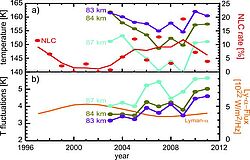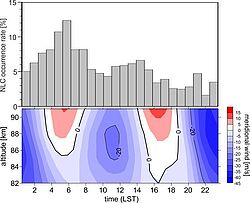NLC and background atmosphere
Knowledge about the occurrence of NLC has increase steadily in the last few years. Recent projects deal with the influence of the background atmosphere on NLC. On the other hand, what can be learned from NLC existence about the background atmosphere like wind, temperature, and water vapour content? Answering this question would enhance the interpretation of the ~130 years of visual NLC observation.
At Kühlungsborn we have collected a unique, multi-year data set of simultaneous lidar and radar soundings of ice particles, temperatures, and winds (since 1997 or 2002, depending on parameter). The NLC occurrence shows a pronounced interannual variation related to the 11 y solar cycle, i.e., the water vapour concentration. At higher latitudes, the relation to solar activity is much weaker. Kühlungsborn is located at mid-latitudes and, therefore, at the edge of the NLC existence area. External factors influencing the NLC can show up more prominent compared to higher latitudes. Furthermore we found, at least during low solar activity, a relation between cold years and high NLC rates as well as between low gravity activity and high NLC rates.
Focussing on individual days, temperature (i.e., the tidal variation of temperature) has a much smaller influence on NLC, as first simultaneous observations of NLC and temperatures during day and night have revealed. The diurnal variation of NLC is instead mainly influenced by ambient winds, advecting the ice particles from the north. The relation between tidal waves and NLC is described here in more detail.
Selected publications
- M. Gerding, G. Baumgarten, M. Zecha, F.-J. Lübken, K. Baumgarten und R. Latteck, On the unusually bright and frequent noctilucent clouds in summer 2019 above Northern Germany, J. Atmos. Solar-Terr. Phys., 217, doi:10.1016/j.jastp.2021.105577, 2021.
- M. Gerding, J. Zöllner, M. Zecha, K. Baumgarten, J. Höffner, G. Stober und F.-J. Lübken, Simultaneous observations of NLCs and MSEs at midlatitudes: Implications for formation and advection of ice particles, Atmos. Chem. Phys., 18, 15569-15580, doi:10.5194/acp-18-15569-2018, 2018.














